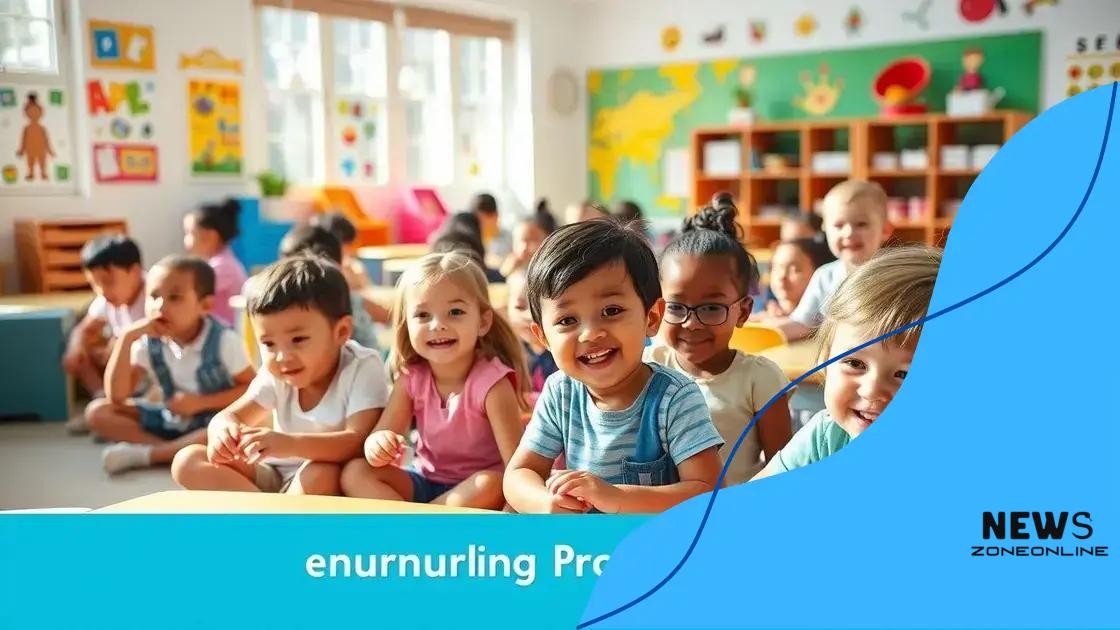Elimination of Head Start funding: what it means for families

The elimination of Head Start funding significantly impacts early childhood education by reducing access to essential resources, affecting children’s learning, family support, and community health outcomes.
The elimination of Head Start funding has sparked significant discussions among parents and educators alike. How will families adapt to changes in early childhood education resources? Let’s delve into the implications and what options lie ahead.
Understanding Head Start funding
Understanding Head Start funding is essential for grasping the impact of its potential elimination. This program provides critical support for low-income families by ensuring that children have access to quality early childhood education. It’s a lifeline for many communities, aimed at closing the achievement gap before children even enter kindergarten.
What is Head Start?
Head Start is a federally funded program designed to promote school readiness for children from low-income families. It covers education, health, nutrition, and social services. Programs are tailored to meet local needs, ensuring that each child receives personalized support.
Benefits of Head Start Funding
Head Start funding plays a vital role in:
- Providing educational resources and qualified teachers.
- Offering health and nutrition services to children and families.
- Supporting family engagement in their children’s education.
- Fostering social and emotional development in young learners.
The loss of such funding could mean a significant setback for many children. Without it, programs might struggle to maintain the same level of service and support, directly affecting families who rely on these resources for their children’s development.
The Funding Structure
Head Start funding comes from various sources, including federal, state, and local governments. The federal government allocates funds through a competitive grant process, allowing local organizations to apply for assistance. This means that the availability of these funds can vary, leading to potential disparities in access to quality programs.
Understanding this structure is crucial, especially when discussing possible changes or reductions in funding. Communities must advocate for maintaining and expanding these essential services to ensure every child has a fair start in life.
Consequences of funding elimination
The elimination of funding for programs like Head Start can have serious consequences for families and children. When funding is cut, many children lose access to educational opportunities that are crucial for their early development. It’s not just about missing out on school; it affects health, nutrition, and future success.
Immediate Impact on Children
One of the most significant effects is on children’s education. Without adequate funding, programs struggle to provide:
- Qualified teachers and staff.
- Essential learning materials and equipment.
- Health screenings and services.
- Nutritional support during meals.
This leads to a gap in learning, making it harder for children to catch up later on. Additionally, the loss of these resources can affect their emotional and social well-being.
Effects on Families
For families, the consequences are just as severe. Without access to affordable early childhood education, parents may have to find alternative care options, which can be both costly and less reliable. This can create stress and uncertainty, making it difficult for parents to work and provide for their families.
The ripple effect of funding cuts also extends to local communities. Early childhood programs often serve as a vital resource for parents, offering support networks and services. When these programs close, families may feel isolated and unsupported.
Long-term Consequences
In the long run, eliminating funding for Head Start can lead to larger societal issues. Children who miss out on early education are at a greater risk of falling behind academically. This can lead to higher dropout rates and increased need for special education services in later grades. As these children grow into adults, their limited education can impact their employment opportunities and earning potential.
A lack of early intervention can also affect health outcomes. Without proper nutrition and health services in their formative years, children may face long-term health challenges that can further hinder their development and success.
Impact on early childhood education

The impact on early childhood education from funding cuts is profound. Early education programs like Head Start play a key role in shaping a child’s future. When funding is reduced, the quality and availability of educational resources can suffer.
Quality of Education
With decreased funding, many programs find it challenging to maintain high standards. This can result in:
- Fewer qualified teachers in classrooms.
- Limited educational materials and resources.
- Increased class sizes that hinder personalized attention.
- Reduced program hours or services, affecting accessibility.
As a consequence, children may not develop the skills they need to succeed in school. They could miss out on essential learning experiences that prepare them for later grades.
Long-term Educational Outcomes
The elimination of quality early childhood education leads to long-lasting effects. Children lacking these foundational experiences are often less prepared when they enter kindergarten. This can result in:
- Lower literacy and numeracy skills.
- Increased likelihood of needing special education services.
- Higher dropout rates in later schooling.
- Challenges in social and emotional development.
These outcomes can create a cycle of disadvantage that affects families and communities. Children who do not receive adequate early education are more likely to struggle academically throughout their school years.
Community Implications
Moreover, the broader community feels the effects of diminished early childhood education. When young children do not receive quality learning experiences, there can be increased burdens on local schools and social services. Communities may see:
- Higher rates of academic failure.
- Increased need for intervention services.
- Strain on local economies due to a less educated workforce.
Understanding the importance of maintaining funding for early childhood education is crucial for ensuring that all children have the opportunity to succeed.
Alternatives for affected families
When families are affected by the elimination of Head Start funding, they often seek alternatives to ensure their children still receive quality education and support. There are various options available that can help bridge the gap.
Local Community Programs
Many communities offer programs that provide similar services to Head Start. These may include:
- Community-based preschool programs.
- Nonprofit organizations focused on child education.
- Parent cooperatives that involve families in the learning process.
These programs can help provide children with essential early learning experiences, often at little or no cost to families. They also help strengthen community ties as parents can become involved in their children’s education.
Online Learning Resources
In today’s digital age, online learning can be a valuable resource. Parents can access numerous educational materials and tools, including:
- Interactive learning apps that cater to young learners.
- Educational websites offering free lessons and activities.
- Online tutoring services for extra academic support.
Leveraging technology can help children continue to learn at home, allowing parents to supplement their education effectively. However, access to devices and the internet is essential for these resources to be beneficial.
Government Assistance and Subsidies
Families can also explore government assistance programs that provide funding for childcare and education. Programs such as:
- Child Care and Development Fund (CCDF).
- Temporary Assistance for Needy Families (TANF).
- State-funded preschool initiatives.
These initiatives can help offset the cost of early childhood education, ensuring that families have access to necessary services even when federal funding is reduced.
By exploring these alternatives, families can still support their children’s growth and development despite the challenges posed by funding cuts.
Advocacy efforts and community responses
Advocacy efforts play a crucial role in addressing the elimination of Head Start funding. When funding is at risk, communities often rally together to support early childhood education programs. These efforts can take many forms and have a significant impact on the outcome for families and children.
Community Engagement
Community members, including parents, educators, and advocates, often engage in activities that raise awareness about the importance of Head Start. Some effective strategies include:
- Organizing rallies and events to demonstrate public support.
- Partnering with local businesses to sponsor initiatives.
- Creating petitions to encourage local and state governments to maintain funding.
Such initiatives help to amplify the voices of those affected, making their concerns heard by decision-makers.
Building Coalitions
Building coalitions among various stakeholders is another key aspect of advocacy. These coalitions may include:
- Nonprofit organizations dedicated to early education.
- Local government agencies and officials.
- Community leaders who understand the needs of families.
By coming together, these groups can share resources and information, increasing their influence when lobbying for funding restoration or alternatives.
Utilizing Social Media
Social media is vital in modern advocacy efforts. Communities use platforms to:
- Share stories of how funding cuts impact children and families.
- Mobilize support quickly for campaigns and events.
- Engage a broader audience in discussions about the importance of early childhood education.
This digital outreach can spark greater community involvement, reaching people who may not be aware of the issue.
In summary, the elimination of Head Start funding has far-reaching effects on children, families, and communities. It impacts education quality, access to essential services, and the support system for families. However, advocacy efforts and community responses can help mitigate these challenges. By engaging in collective action, utilizing digital platforms, and exploring alternative resources, communities can ensure that children continue to receive the support they need for a successful future. Together, we can make a difference in the lives of those affected by funding cuts.
FAQ – Frequently Asked Questions about Head Start Funding Eliminations
What is Head Start funding?
Head Start funding supports early childhood education programs for low-income families, providing essential services to help children prepare for school.
How does the elimination of funding affect families?
Families lose access to critical educational resources, which can lead to increased stress and challenges in finding affordable childcare options.
What advocacy efforts can communities undertake?
Communities can organize rallies, build coalitions, and use social media to raise awareness and lobby for the restoration of funding.
What alternatives exist for children impacted by funding cuts?
Alternatives include local community programs, online educational resources, and government assistance programs that help families access quality education.





